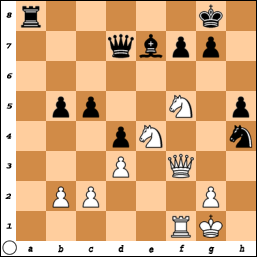The following position demonstrates that besides building up my knowledge and skill in various areas such as openings, strategy, and endgame fundamentals, it is always paramount for every player to be wary of tactics, both offensively and defensively. I offer the following position as both a tactics problem for you and a painful reminder for me to always be careful.
I am playing black and made the horrible move
1...Nxh4?? This move took a slightly worse game and turned it into a losing game. Unfortunately, my opponent did not find the solution and lost the game. Can you? Check the comments for the answer.



White starts the winning combination with 2.Nh6+! after 2...gxh6 3.Qxf7+ Kh8 4.Nf6! and Black loses his queen after 4...Bxf6 (to prevent mate) 5.Qxd7
ReplyDeleteIf 2...Kh8 3.Nxf7+ Kg8 4.Qxh5! threatening mate on h8 and Black has to throw away too much material to avoid mate.
Bryan -
ReplyDeleteI rejected 2. Nh6+ because of 2...Kh7 3. Qxf7 Kxh6 and at first glance black seems to defend successfully.
On the other hand, 2. Nf6+ Bxf6 3. Qxa8+ Kh7 4. Nxh4 picks up the exchange for white. Again, this is not deep analysis.
After 2.Nh6+ Kh7 3.Qxh5! threatening Nxf7+ and Qh8#
ReplyDeleteSo 3...gxh6 4.Rxf7+ and it's mate in two:
a)4...Kg8 5.Qg6+ Kh8 6.Qh7#
b)4...Kh8 5.Qxh6+ Kg8 6.Qh7#
If 3...Ng6 4.Nxf7+ Kg8 5.Qxg6 there is no forced mate, but White is up a lot of material. I should have considered this in my original answer, so good job pointing it out!
2.Nf6+ Bxf6 3.Qxa8+ only leads to a small advantage for White after 3...Qd8 as Black has a couple extra pawns for the exchange, while the 2.Nh6+ line is a forced win.
What a position to put myself in (as Black)!
Excellent analysis! 3. Qxh5 is the kind of move that I have a hard time seeing because
ReplyDelete1. it's rather quiet (not a check)
2. it seems to leave the knight hanging, and
3. it is not a useful move in the original position.
Of course the knight is protected by the mate threat, as you point out.
It's probably worth pointing out that 3... g6 also fails to 4. Rxf7+ Kh8 5. Qe5+ and mate in one.
Yeah, it is not very obvious, but having played the game, the move was already in my mind.
ReplyDeleteAh...also, I just finished the chapter on discovered and double checks in Art of the Checkmate, so the motif is fresh in my mind! I knew that book would be good for something. :)
ReplyDelete